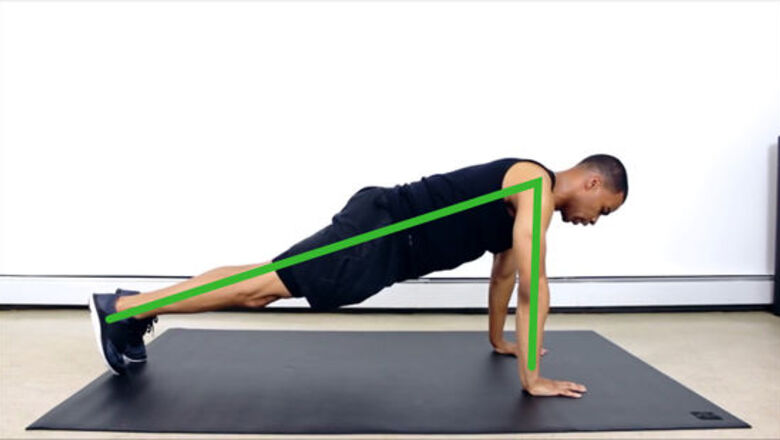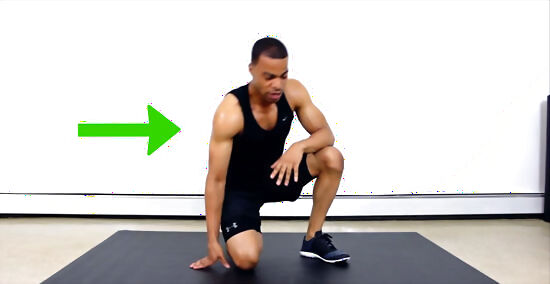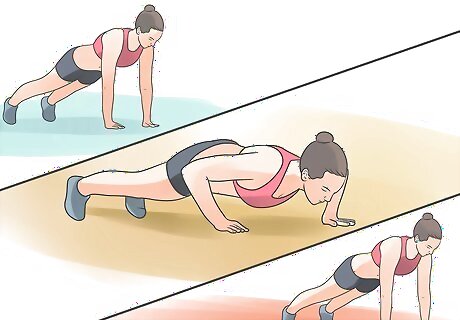
views
Doing Push-Ups Three-to-Four Times Per Week

Develop a proper push-up technique. In order to take accurate readings of the push-ups you do, you must first make sure you’re performing a proper push-up each time. A push-up in good form will work your chest, arms, shoulders, and upper body. You want to keep your arms just over shoulder-width apart and keep both your back and legs straight for every repetition. For more information on proper push-up technique, you can visit: How to Do a Push-Up. Remember that you only go low enough for your chin to touch the floor while keeping the rest of your body elevated.

Do as many push-ups as you can. In order to increase the number of push-ups you can do, you must first find out what that number is. Do as many push-ups as you can in good form until you feel the muscles shake and you simply cannot do another. You also want to time the amount of time it takes you to do your maximum number of push-ups.

Rest between sets. You want to allow yourself to rest for the same amount of time that it took you to do the first set of push-ups. For most beginners taking a baseline reading, this will likely be between 45 seconds and 2 minutes. Since you need to track your baseline and progress, take the rest time to write down the number of push-ups you did.

Perform a second and third set of push-ups, taking the same rest between each. One single set of push-ups alone will not work the muscle groups enough to see overall progress very quickly, so you want to perform at least three sets of as many push-ups as you can do. You want to continue timing each set, so you can take an equivalent-length rest between each set. It’s perfectly normal to perform fewer push-ups until muscle failure with each subsequent set, so don’t allow that to discourage you. With practice, you’ll see increases in the number in each set you can do.

Chart your baseline. Once you have done all three sets of your maximum amount of push-ups, chart your baseline for sets one, two, and three as well as the amount of time that each set took you.

Wait two days. You’re likely to feel some ache in your muscles the day after your baseline, which is perfectly normal. You may be itching to get started on doing more push-ups, but this routine will offer the best results if you do it three-to-four times per week so basically, every other day. EXPERT TIP Monica Morris Monica Morris ACE Certified Personal Trainer Monica Morris is an ACE (American Council on Exercise) Certified Personal Trainer based in the San Francisco Bay Area. With over 15 years of fitness training experience, Monica started her own physical training practice and gained her ACE Certification in 2017. Her workouts emphasize proper warm-ups, cool-downs, and stretching techniques. Monica Morris Monica Morris ACE Certified Personal Trainer Waiting 3 days may offer even more benefits. Let's say you do your push-ups on one day. If you do them the next day, it will tax your muscle fibers and you won't develop as much muscle. You also won't be able to perform the same, because those muscles will be tired. I suggest doing push-ups maybe every 3 days, and try to do more each time than you did before. So if you do 20 push-ups, you'd wait 3 days, then try to do 22 the next time, then 24 the time after that.

Try to increase the number in each set by one. When the next workout day comes around, perform the same routine you did to find your baseline, but try to increase the number in each set of push-ups by at least one. You likely will not be able to increase the number in each set every time you work out, but that’s okay. If you reach such a plateau, hold yourself to that number for three or four workout sessions, and then try to increase the amount after several days. Continue charting the results, and you’ll begin seeing more push-ups performed in less time over several weeks.

Vary your push-up types. Once you’re comfortable with this routine, you can start working additional muscle groups by varying the type of push-up you do. Follow the same set structure, but try diamond push-ups for the first set, standard push-ups for the second set, and do the third set with your arms set slightly wider. This will give you a more complete workout of the push-up muscle groups. You’ll definitely notice that you’re capable of fewer overall push-ups with this variation, so take a new baseline measurement to start with.
Doing Push-Ups Every Day

Develop the proper push-up technique. As with the first step in the first method, you want to make sure that you’re performing correct push-ups for each repetition. You can find more information for push-up form at: How to Do a Push-Up.

Do as many push-ups as you can. This method also requires a baseline measurement of how many push-ups you can do; however, you’re not going to do several sets. Perform just one set of as many push-ups as possible until you cannot do more. As you’re doing the push-ups, keep a mental tally of how many you were able to do comfortably and where the push-ups become more difficult. This will vary greatly from person to person.

Wait two days. Since you did push-ups to exhaustion while discovering your baseline, wait two days before beginning your daily regimen. This will give your muscles time to rest before you begin the larger project.

Begin a daily regimen. Using the number right where your push-ups went from comfortable to more difficult during your baseline test, begin doing a single set of this many push-ups per day for a week. By doing a number right at the edge of your comfort level but not to exhaustion, you’re putting less strain on your muscles, which makes a more sustainable daily regimen. Even within the seven day period, you can create smaller goals for yourself by trying to decrease the amount of time it takes you to do your push-ups.

Increase the number of push-ups each week. This method offers a more controlled way of increasing your push-up count by allowing you to gradually increase the number each week. If your number for the first week was ten push-ups per day, try increasing that number to eleven or twelve per day in the second week and so on across subsequent weeks. Remember not to increase the number in such a way that you’re doing push-ups to exhaustion because that type of rigorous daily strain can damage your muscles and set you back while you recover.

















Comments
0 comment